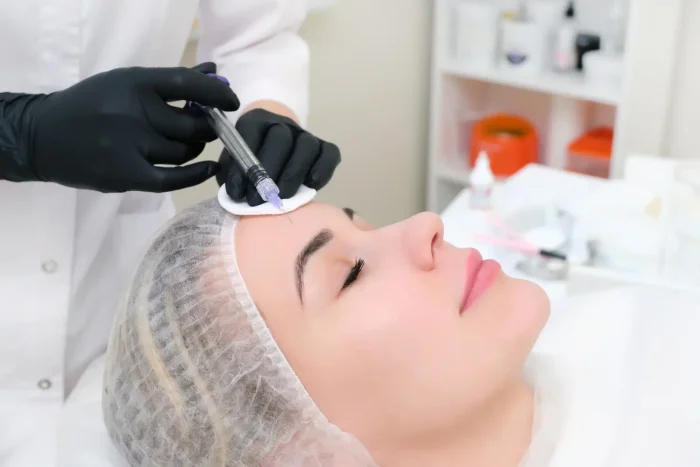Only for Licensed Professionals
Only for Licensed Professionals

Nabota Mixing Instructions for Medical Practitioners
David Fuller
Last Updated On: June 17, 2024
Botulinum toxin type A, commonly used for cosmetic treatments, isn’t as straightforward as it seems. A recent study explored how different dilutions affect its effectiveness and safety.
Nabota is a fresh take on botulinum toxin type A. It’s derived from wild-type Clostridium botulinum Hall A and purified meticulously. Unlike other formulations, Nabota offers a single 900 kDa peak with impressive purity. It smooths wrinkles, reduces fine lines, and enhances facial aesthetics, offering an advanced approach to anti-aging solutions.
In this article, we’ll guide doctors through properly mixing Nabota so they can use this treatment safely and effectively.
Key Takeaways
- Mix Nabota gently with 0.9% sodium chloride solution to ensure it’s clear and compelling.
- Store the mixed Nabota in a fridge at 2 to 8 degrees Celsius and use within 24 hours.
- Follow manufacturer guidelines and regulatory standards to keep patients safe.
- Always wear gloves and use sterile equipment to mix to prevent contamination.
- Check the mixed solution for clarity and freedom from particles before injecting it into patients.
About: Operating since 2016, Med Supply Solutions is known for being one of the industry’s top and trusted suppliers of cosmetic and viscosupplementation products. If you’re looking to buy Nabota online, contact our sales department for more information.
Introduction to Nabota
Nabota, a botulinum toxin type A product, is highly effective for treating glabella lines, such as those frown lines between the eyebrows. Proper mixing and preparation are crucial to ensure its safety and efficacy.

Medical professionals must mix Nabota with 0.9% sodium chloride, making the solution clear and particles-free. Marking the date and time of mixing helps track the solution’s freshness. Accurate dosages and correct saline amounts are essential for successful treatment, minimizing side effects.
Nabota’s FDA approval underscores its high standard of safety and efficacy, making it a reliable option compared to Botox, Dysport, Xeomin, Botulax, and other similar products. Gentle mixing by rotating the vial and careful attention to detail ensures the product’s effectiveness.
Proper preparation also helps medical practitioners confidently deliver treatments, ensuring patients achieve the desired results without unnecessary side effects. Storing Nabota properly maintains its effectiveness, providing consistent, safe treatments for patients with glabella lines.
Reconstitution of Nabota
Mixing Nabota correctly is vital for medical professionals to ensure the treatment’s effectiveness. Here’s a straightforward guide to reconstituting Nabota with precision.

- Gather all necessary items: Nabota vial, sterile 0.9% sodium chloride solution, syringe, and needle.
- Check the expiration date on the Nabota vial to ensure it’s safe for use.
- Wash hands thoroughly to maintain aseptic techniques throughout the process.
- Open the sodium chloride solution, preparing it for withdrawal.
- Using a new syringe and needle, withdraw the recommended amount of 0.9% sodium chloride solution.
- Gently insert the needle through the rubber stopper of the Nabota vial.
- Slowly inject the saline into the vial containing Nabota powder.
- Rotate the vial gently to mix without shaking vigorously; this maintains product integrity.
- Examine the mixture carefully to confirm it is clear and particles-free, ensuring safety before administration.
- Label the mixed Nabota with the date and time of reconstitution to track its shelf life accurately.
Selection of Appropriate Diluent and Volume
The suitable diluent for reconstituting Nabota is a sterile 0.9% sodium chloride solution. Accurate measurements and ensuring that the solution is clear and particles-free are crucial. Marking the vial with the date and time of mixing helps track its freshness.
Medical professionals must dilute Nabota with precision for each patient. The goal is a clear, particle-free solution ready for safe administration. Recording the date and time after reconstituting Nabota adds another layer of detail, ensuring quality control from start to finish.
Maintaining Aseptic Techniques
Maintaining a clean space and following aseptic techniques are crucial when handling Nabota. This involves using sterilized equipment, wearing gloves, and avoiding contact with non-sterile surfaces to prevent contamination.
Additionally, checking the Nabota vial for clarity and particles before use is essential. These measures reduce patient risks and support successful outcomes, ensuring the safety and efficacy of Nabota treatments and maintaining trust in its FDA approval for aesthetic improvements.
Guidelines for Maintaining Sterility During the Mixing Process
The mixing process is crucial for keeping Nabota safe and effective. This step requires a clean technique to avoid contamination.
- Always wash your hands before starting the mixing process. Clean hands prevent germs from getting into the Nabota solution.
- Use sterile gloves to handle Nabota and its diluent, usually 0.9% sodium chloride, which is key for reconstitution.
- Make sure the work area is clean and free from clutter. A tidy space reduces the risk of contamination.
- Open Nabota and diluent packages right before using them to keep them sterile.
- Check that both Nabota vial and saline solution are clear and particle-free, ensuring they’re safe for patient use.
- Before adding saline to Nabota, gently rotate (not shake) the vial to minimize potential damage to the product.
- For each patient, draw up the correct amount of 0.9% sodium chloride with a new, sterile syringe.
- Slowly inject saline into the Nabota vial, aiming the needle against the glass wall to avoid creating bubbles.
- After adding saline, gently rotate the vial until well mixed; don’t shake it as shaking can ruin its efficacy.
- Dispose of all used needles and syringes in a proper sharps container immediately after use to avoid accidents.
Common Issues and Troubleshooting
Mixing Nabota the right way is key for medical professionals. Sometimes, things need to be corrected. Here are some tips to fix common issues.
- Before injecting, check whether the Nabota solution is clear and particles-free. If you notice cloudiness or particles, don’t use it.
- Use only 0.9% sodium chloride for reconstitution to avoid mixing errors.
- Rotate the vial gently to mix Nabota with saline. This ensures an even solution without creating bubbles.
- If bubbles form during mixing, let the vial sit for a few minutes until they settle.
- Always measure accurately when diluting Nabota with saline. Mistakes in volume can lead to incorrect dosages.
- Write down the date and time of reconstitution on the vial. This helps track its shelf life and ensure it’s used within safe limits.
- Store the reconstituted solution as recommended, usually in a fridge, to maintain efficacy.
- Review your technique and solution preparation for patients reporting Nabota side effects after the treatment.
- Compare Nabota’s effect before and after treatment to assess whether there was an error in dosage or administration technique.
- Keep up-to-date with Nabota FDA approval guidelines and any changes in recommended practices for safety.
Storage and Shelf Life
Proper storage of Nabota is crucial for maintaining its effectiveness. After reconstituting the solution with 0.9% sodium chloride, store it in a refrigerator at 2 to 8 degrees Celsius. Do not freeze it; use it within 24 hours for best results. Keep track of the mixing date and time, and make sure your fridge is set to the correct temperature.
Proper documentation is essential, so mark the vial clearly with the details after reconstitution. This practice ensures the treatment remains effective and safe for patient use within the recommended shelf life span.
Adhering to Manufacturer Guidelines and Regulatory Standards
Following the rules and health standards of the Nabota makers is crucial for safe and effective treatments. Doctors must adhere to the manufacturer’s instructions to ensure Nabota works as intended and keeps patients safe. These guidelines cover everything from proper mixing to usage, helping medical professionals avoid common mistakes and provide better care.
In addition to following manufacturer guidelines, adhering to regulatory standards that ensure Nabota’s safety and efficacy is essential. Doctors must be well-versed in these regulations and adhere to strict standards to guarantee patient safety.
Every country has its own rules for mixing and using Nabota, with the FDA setting the rules in the U.S. Sticking to industry regulations and best practices ensures that patients receive safe and effective treatment. Proper storage conditions and adherence to rules help avoid common problems and provide top care for patients seeking smoother skin without glabella lines.
Conclusion
Mixing Nabota correctly is critical for safe and effective treatment. Medical professionals must follow steps closely, use the correct saline solution, and keep everything sterile. Always check for clear solutions without particles before using. Keep track of when you mix Nabota to ensure it stays good. Getting this process right means better care for patients with fewer risks.
FAQs
1. What do I need to mix Nabota?
You’ll need a vial of Nabota, saline solution, and a sterile syringe.
2. How much saline should I use for mixing?
Use 2.5 mL of saline for every 100 units of Nabota to get the right mix.
3. Can I store mixed Nabota for later use?
You should use the mixed Nabota immediately; it’s not good after that.
4. How do I know if it’s mixed well?
Gently swirl the vial until the solution is clear and free from particles.
5. Is there a specific technique for injecting Nabota once mixed?
Inject slowly and carefully into the targeted area using proper medical techniques.
References
Alam M. Dilution, Reconstitution, and Complexity. Archives of Dermatology. 2012;148(1):121. doi:https://doi.org/10.1001/archderm.148.1.121
The Dilution Confusion: Easy Dosing for Botulinum Toxins. www.linkedin.com. Accessed May 25, 2024. https://www.linkedin.com/pulse/dilution-confusion-easy-dosing-botulinum-toxins-julie-bass/
Products
Cart
Log In
Newsletter
Subscribe for exclusive offers and updates on new arrivals
Share feedback at:
Working Hours
MON - SUN 9AM to 6PM EST
The Most Popular Brands
Med Supply Solutions
Support
Secure checkout is guaranteed with full adherence to PCI DSS payment standards.
Products listed here are guaranteed authentic and manufacturer-sourced.
Pay easily with trusted providers


*Google and Apple Pay are currently only available via a direct link provided by your account manager.
Copyright 2026. Med Supply Solutions